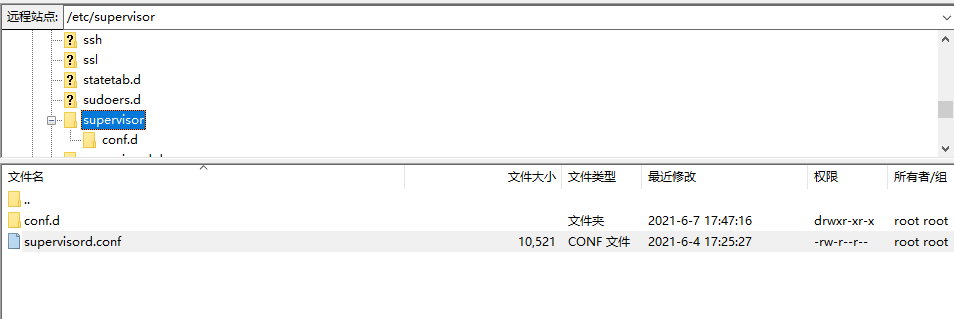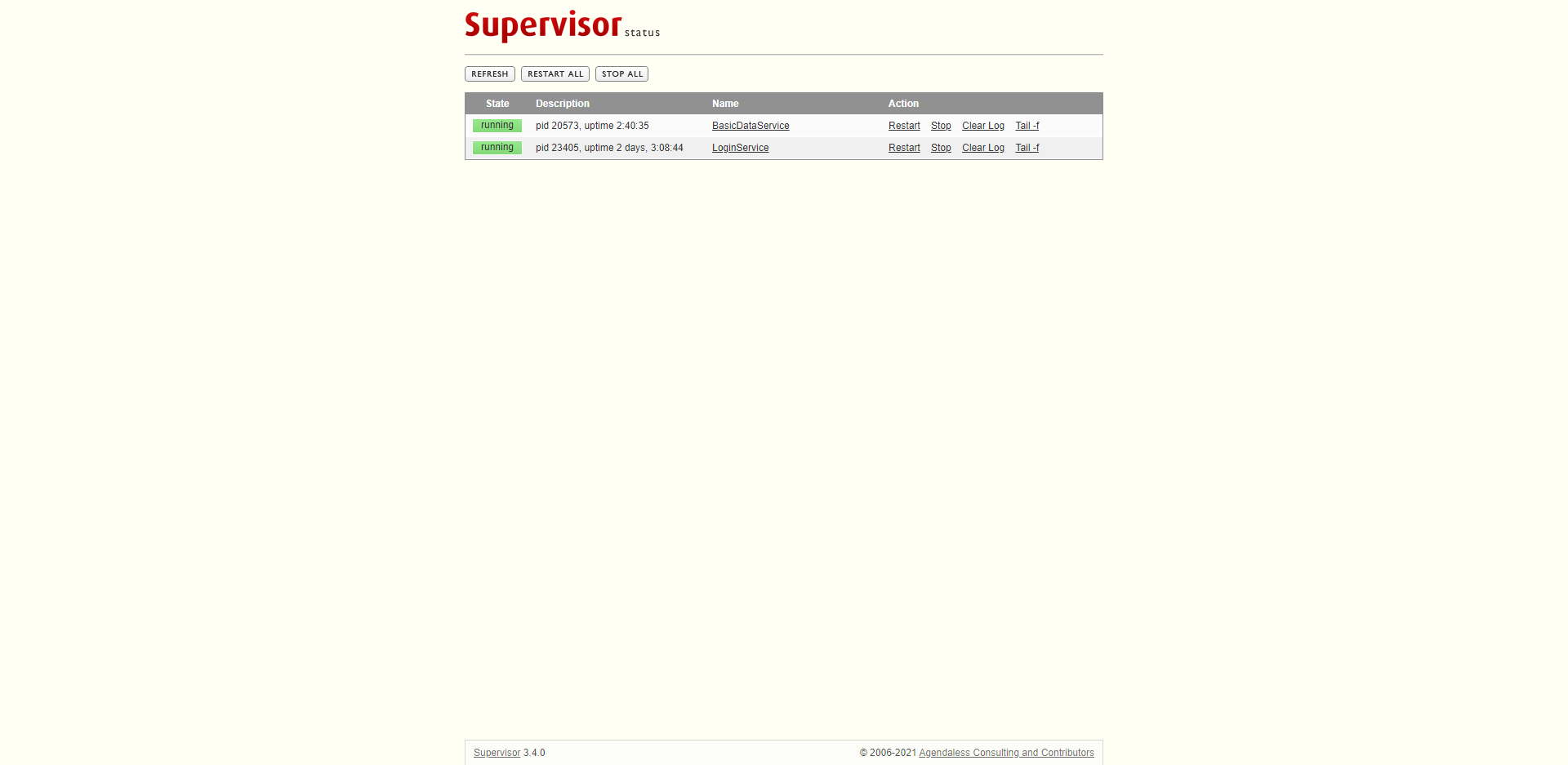- 首先安装Supervisor
yum install epel-release yum install -y supervisor - 新增supervisor 的配置
#首先添加配置文件 vim /etc/supervisor/supervisord.conf ; Sample supervisor config file. ; ; For more information on the config file, please see: ; http://supervisord.org/configuration.html ; ; Notes: ; - Shell expansion ("~" or "$HOME") is not supported. Environment ; variables can be expanded using this syntax: "%(ENV_HOME)s". ; - Quotes around values are not supported, except in the case of ; the environment= options as shown below. ; - Comments must have a leading space: "a=b ;comment" not "a=b;comment". ; - Command will be truncated if it looks like a config file comment, e.g. ; "command=bash -c 'foo ; bar'" will truncate to "command=bash -c 'foo ". ; ; Warning: ; Paths throughout this example file use /tmp because it is available on most ; systems. You will likely need to change these to locations more appropriate ; for your system. Some systems periodically delete older files in /tmp. ; Notably, if the socket file defined in the [unix_http_server] section below ; is deleted, supervisorctl will be unable to connect to supervisord. [unix_http_server] file=/tmp/supervisor.sock ; the path to the socket file ;chmod=0700 ; socket file mode (default 0700) ;chown=nobody:nogroup ; socket file uid:gid owner ;username=user ; default is no username (open server) ;password=123 ; default is no password (open server) ; Security Warning: ; The inet HTTP server is not enabled by default. The inet HTTP server is ; enabled by uncommenting the [inet_http_server] section below. The inet ; HTTP server is intended for use within a trusted environment only. It ; should only be bound to localhost or only accessible from within an ; isolated, trusted network. The inet HTTP server does not support any ; form of encryption. The inet HTTP server does not use authentication ; by default (see the username= and password= options to add authentication). ; Never expose the inet HTTP server to the public internet. [inet_http_server] ; inet (TCP) server disabled by default port=0.0.0.0:6001 ; ip_address:port specifier, *:port for all iface ;username=bbss ; default is no username (open server) ;password=123456 ; default is no password (open server) [supervisord] logfile=/tmp/supervisord.log ; main log file; default $CWD/supervisord.log logfile_maxbytes=50MB ; max main logfile bytes b4 rotation; default 50MB logfile_backups=10 ; # of main logfile backups; 0 means none, default 10 loglevel=info ; log level; default info; others: debug,warn,trace pidfile=/tmp/supervisord.pid ; supervisord pidfile; default supervisord.pid nodaemon=false ; start in foreground if true; default false minfds=1024 ; min. avail startup file descriptors; default 1024 minprocs=200 ; min. avail process descriptors;default 200 ;umask=022 ; process file creation umask; default 022 ;user=supervisord ; setuid to this UNIX account at startup; recommended if root ;identifier=supervisor ; supervisord identifier, default is 'supervisor' ;directory=/tmp ; default is not to cd during start ;nocleanup=true ; don't clean up tempfiles at start; default false ;childlogdir=/tmp ; 'AUTO' child log dir, default $TEMP ;environment=KEY="value" ; key value pairs to add to environment ;strip_ansi=false ; strip ansi escape codes in logs; def. false ; The rpcinterface:supervisor section must remain in the config file for ; RPC (supervisorctl/web interface) to work. Additional interfaces may be ; added by defining them in separate [rpcinterface:x] sections. [rpcinterface:supervisor] supervisor.rpcinterface_factory = supervisor.rpcinterface:make_main_rpcinterface ; The supervisorctl section configures how supervisorctl will connect to ; supervisord. configure it match the settings in either the unix_http_server ; or inet_http_server section. [supervisorctl] serverurl=unix:///tmp/supervisor.sock ; use a unix:// URL for a unix socket ;serverurl=http://127.0.0.1:9001 ; use an http:// url to specify an inet socket ;username=chris ; should be same as in [*_http_server] if set ;password=123 ; should be same as in [*_http_server] if set ;prompt=mysupervisor ; cmd line prompt (default "supervisor") ;history_file=~/.sc_history ; use readline history if available ; The sample program section below shows all possible program subsection values. ; Create one or more 'real' program: sections to be able to control them under ; supervisor. ;[program:theprogramname] ;command=/bin/cat ; the program (relative uses PATH, can take args) ;process_name=%(program_name)s ; process_name expr (default %(program_name)s) ;numprocs=1 ; number of processes copies to start (def 1) ;directory=/tmp ; directory to cwd to before exec (def no cwd) ;umask=022 ; umask for process (default None) ;priority=999 ; the relative start priority (default 999) ;autostart=true ; start at supervisord start (default: true) ;startsecs=1 ; # of secs prog must stay up to be running (def. 1) ;startretries=3 ; max # of serial start failures when starting (default 3) ;autorestart=unexpected ; when to restart if exited after running (def: unexpected) ;exitcodes=0 ; 'expected' exit codes used with autorestart (default 0) ;stopsignal=QUIT ; signal used to kill process (default TERM) ;stopwaitsecs=10 ; max num secs to wait b4 SIGKILL (default 10) ;stopasgroup=false ; send stop signal to the UNIX process group (default false) ;killasgroup=false ; SIGKILL the UNIX process group (def false) ;user=chrism ; setuid to this UNIX account to run the program ;redirect_stderr=true ; redirect proc stderr to stdout (default false) ;stdout_logfile=/a/path ; stdout log path, NONE for none; default AUTO ;stdout_logfile_maxbytes=1MB ; max # logfile bytes b4 rotation (default 50MB) ;stdout_logfile_backups=10 ; # of stdout logfile backups (0 means none, default 10) ;stdout_capture_maxbytes=1MB ; number of bytes in 'capturemode' (default 0) ;stdout_events_enabled=false ; emit events on stdout writes (default false) ;stdout_syslog=false ; send stdout to syslog with process name (default false) ;stderr_logfile=/a/path ; stderr log path, NONE for none; default AUTO ;stderr_logfile_maxbytes=1MB ; max # logfile bytes b4 rotation (default 50MB) ;stderr_logfile_backups=10 ; # of stderr logfile backups (0 means none, default 10) ;stderr_capture_maxbytes=1MB ; number of bytes in 'capturemode' (default 0) ;stderr_events_enabled=false ; emit events on stderr writes (default false) ;stderr_syslog=false ; send stderr to syslog with process name (default false) ;environment=A="1",B="2" ; process environment additions (def no adds) ;serverurl=AUTO ; override serverurl computation (childutils) ; The sample eventlistener section below shows all possible eventlistener ; subsection values. Create one or more 'real' eventlistener: sections to be ; able to handle event notifications sent by supervisord. ;[eventlistener:theeventlistenername] ;command=/bin/eventlistener ; the program (relative uses PATH, can take args) ;process_name=%(program_name)s ; process_name expr (default %(program_name)s) ;numprocs=1 ; number of processes copies to start (def 1) ;events=EVENT ; event notif. types to subscribe to (req'd) ;buffer_size=10 ; event buffer queue size (default 10) ;directory=/tmp ; directory to cwd to before exec (def no cwd) ;umask=022 ; umask for process (default None) ;priority=-1 ; the relative start priority (default -1) ;autostart=true ; start at supervisord start (default: true) ;startsecs=1 ; # of secs prog must stay up to be running (def. 1) ;startretries=3 ; max # of serial start failures when starting (default 3) ;autorestart=unexpected ; autorestart if exited after running (def: unexpected) ;exitcodes=0 ; 'expected' exit codes used with autorestart (default 0) ;stopsignal=QUIT ; signal used to kill process (default TERM) ;stopwaitsecs=10 ; max num secs to wait b4 SIGKILL (default 10) ;stopasgroup=false ; send stop signal to the UNIX process group (default false) ;killasgroup=false ; SIGKILL the UNIX process group (def false) ;user=chrism ; setuid to this UNIX account to run the program ;redirect_stderr=false ; redirect_stderr=true is not allowed for eventlisteners ;stdout_logfile=/a/path ; stdout log path, NONE for none; default AUTO ;stdout_logfile_maxbytes=1MB ; max # logfile bytes b4 rotation (default 50MB) ;stdout_logfile_backups=10 ; # of stdout logfile backups (0 means none, default 10) ;stdout_events_enabled=false ; emit events on stdout writes (default false) ;stdout_syslog=false ; send stdout to syslog with process name (default false) ;stderr_logfile=/a/path ; stderr log path, NONE for none; default AUTO ;stderr_logfile_maxbytes=1MB ; max # logfile bytes b4 rotation (default 50MB) ;stderr_logfile_backups=10 ; # of stderr logfile backups (0 means none, default 10) ;stderr_events_enabled=false ; emit events on stderr writes (default false) ;stderr_syslog=false ; send stderr to syslog with process name (default false) ;environment=A="1",B="2" ; process environment additions ;serverurl=AUTO ; override serverurl computation (childutils) ; The sample group section below shows all possible group values. Create one ; or more 'real' group: sections to create "heterogeneous" process groups. ;[group:thegroupname] ;programs=progname1,progname2 ; each refers to 'x' in [program:x] definitions ;priority=999 ; the relative start priority (default 999) ; The [include] section can just contain the "files" setting. This ; setting can list multiple files (separated by whitespace or ; newlines). It can also contain wildcards. The filenames are ; interpreted as relative to this file. Included files *cannot* ; include files themselves. [include] files = conf.d/*.conf
[include] 表示 导入conf.d下面的所有配置文件
- 配置netcore 服务
#添加配置 vim /etc/supervisor/conf.d/loginservice.conf [program:LoginService] command=dotnet LoginService.dll --urls "http://*:5002" ; directory=/usr/local/src/loginservice/ ; autorestart=true ; stderr_logfile=/var/log/LoginService.err.log ; stdout_logfile=/var/log/LoginService.out.log ; environment=ASPNETCORE_ENVIRONMENT=Production ; user=root ; stopsignal=INT
command 为启动服务所需执行的命令 directory 为执行命令的文件夹。其他的见名知意。
- 配置go 服务
#添加配置 vim /etc/supervisor/conf.d/BasicDataService.conf #/etc/supervisor/conf.d/basicservice.conf [program:BasicDataService] directory=/usr/local/src/goservice command=/usr/local/src/goservice/BasicDataService -conf /usr/local/src/goservice/configs/config.yaml stderr_logfile=/var/log/basicservice.err stdout_logfile=/var/log/basicservice.log autostart=true autorestart=true startsecs=10 stdout_logfile_maxbytes=1MB stdout_logfile_backups=10 stdout_capture_maxbytes=1MB stderr_logfile_maxbytes=1MB stderr_logfile_backups=10 stderr_capture_maxbytes=1MB stopsignal=INT [supervisord]
command 添加了环境变量-conf 表示配置文件的目录
- 最终目录结构如下

- 手动启动supervisor 服务
supervisord -c /etc/supervisor/supervisord.conf
- 最终启动成功如下

- 其他的一些常用命令
supervisorctl stop all,停止全部进程,注:start、restart、stop都不会载入最新的配置文件。 supervisorctl reload,载入最新的配置文件,停止原有进程并按新的配置启动、管理所有进程。 supervisorctl update,根据最新的配置文件,启动新配置或有改动的进程,配置没有改动的进程不会受影响而重启。 supervisorctl stop programxxx,停止某一个进程(programxxx),programxxx为[program:chatdemon]里配置的值,这个示例就是chatdemon。 supervisorctl start programxxx,启动某个进程 supervisorctl restart programxxx,重启某个进程